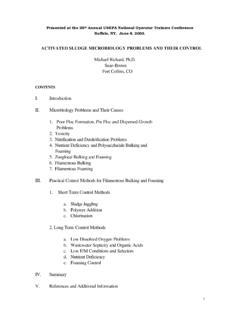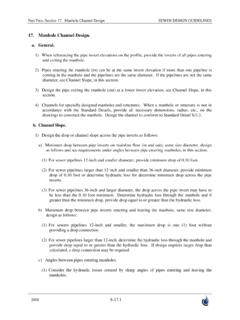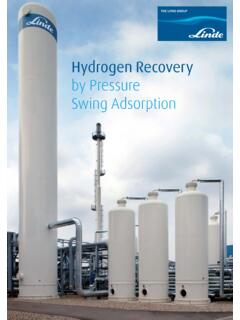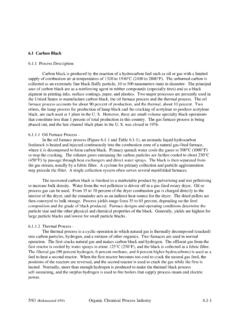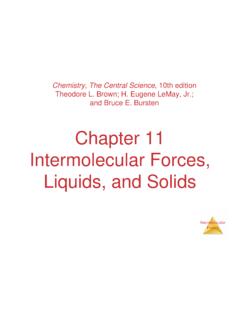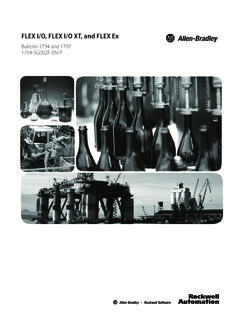Transcription of Underground Construction (Tunneling)
1 Construction (Tunneling) OSHA 3115-06R 2003 This informational booklet provides a general overview of a particular topic related to OSHA standards. It does not alteror determine compliance responsibilities inOSHA standards or the Occupational Safetyand Health Act of 1970. Because interpreta-tions and enforcement policy may changeover time, you should consult current OSHA administrative interpretations and decisionsby the Occupational Safety and HealthReview Commission and the Courts for additional guidance on OSHA publication is in the public domain and may be reproduced, fully or partially,without permission.
2 Source credit is requested but not information is available to sensoryimpaired individuals upon phone: (202) 693-1999; teletypewriter(TTY) number: (877) Construction (Tunneling) Department of LaborElaine L. Chao, SecretaryOccupational Safety and Health AdministrationJohn L. Henshaw, Assistant SecretaryOSHA operations covered by the OSHA and employees covered by the OSHA of the OSHA need for a competent person ..6 Training and communication control of access and support of portal and subsidence support of Underground support of prevention and Special air monitoring for oxygen for methane and other flammable sulfide conditions for drilling and blasting requirements for using cranes and hoists hazards that require special or potentially gassy OSHA and health management system consultation OSHA Voluntary Protection Program (VPP).
3 24 Strategic Partnership OSHA Alliance training and available Regional Construction of Underground tunnels, shafts, chambers, andpassageways are essential yet dangerous activities. Working underreduced light conditions, difficult or limited access and egress, withthe potential for exposure to air contaminants and the hazards offire and explosion, Underground Construction workers face manydangers. To help employers protect the safety and health of under-ground Construction workers, the Occupational Safety and HealthAdministration (OSHA) has prepared a number of guidancedocuments, including the Underground Construction regulations,found in Part 1926, section 800 of Title 29 of the Code of FederalRegulations (29 CFR ).
4 OSHA regulations relating to Underground Construction wereoriginally adopted in 1971 and revised over the years to add newprotective measures and enhance worker safety. This publicationsummarizes OSHA s regulations related to Underground construc-tion. As such, it should be used as a guide but not as a substitutefor the complete text of 29 CFR operations covered by the OSHA standardThe OSHA Underground Construction regulation (29 ) applies to the Construction of Underground tunnels,shafts, chambers, and passageways. It also applies to cut-and-cover excavations connected to ongoing Underground constructionas well as those that create conditions characteristic of under-ground Construction .
5 These hazards include reduced natural venti-lation and light, difficult and limited access and egress, exposure toair contaminants, fire, flooding, and explosion. The regulation doesnot apply to excavation and trenching operations for above groundstructures that are not physically connected to an Underground con-struction operation or to Underground electrical transmission anddistribution has developed the following definitions for constructionactivities that fall within the Underground Construction field:4A tunnel is an excavation beneath the surface of the ground,the longer axis of which makes an angle not greater than 20degrees to the horizontal.
6 A shaft is (1) a passage made from the surface of the ground toa point Underground , the longer axis of which makes an anglegreater than 20 degrees to the horizontal; or (2) a pit in which thereare employees, and it is foreseeable that they may enter (or doenter) the horizontal excavation; or (3) a pit that has typical Underground Construction hazards and is connected to a horizontal excavation. Employers and employees covered by the OSHA standardIn general, OSHA authority extends to all private sectoremployers with one or more employees, as well as to civilianemployees in federal agencies.
7 As such, OSHA coverage applies toemployers and employees in the Construction industry. Workersnot covered by OSHA include the self-employed; public employeesof state and local governments; employees whose working condi-tions are regulated by other federal agencies, such as mine workersand atomic energy workers; and immediate family members offarming operations that do not employ outside can administer their own occupational safety and healthprograms through plans approved by the Department of Laborunder section 18(b) of the Occupational Safety and Health (OSH)Act of 1970, but they must enforce standards that are at least aseffective as federal requirements.
8 In 2003, 26 states operated theirown safety and health programs under approved programs. (SeeOSHA s website at for a list of those states.) Ofthese, 23 states cover both private and public employees whilethree states cover only public sector employees. State safety and health standards under approved plans must either be identical to or at least as effective as federal OSHA of the OSHA standardThe Underground Construction standard covers many topics ofconcern to those who work in the challenging environment ofunderground Construction . A sampling of items covered by thestandard includes requirements for safe access and egress routes,employee training in hazard recognition, a check-in/check-out procedure, and emergency procedures.
9 This booklet summarizesall requirements of the standard provides some flexibility in methods to controlworkplace hazards in Underground Construction as long as appro-priate precautions are taken to protect workers in a variety of situa-tions. OSHA requires that a competent person be responsible forcarrying out several requirements of the Underground constructionregulations. Situations that require intervention by a competentperson are identified in the following need for a competent person The definition of a competent person in 29 CFR (f) isas follows:One who is capable of identifying existing and predictablehazards in the surroundings or working conditions which areunsanitary, hazardous, or dangerous to employees, and who hasauthorization to take prompt correctivemeasures to eliminate Subpart S, Underground Construction , caissons, coffer-dams, and compressed air, a competent person is responsible forinspecting and evaluating workplace conditions, including air moni-toring and the presence of air contaminants, ground stability, andthe drilling, hauling and hoisting of equipment.
10 To identify andcorrect any requirementsAll employees involved in Underground Construction must betrained to recognize and respond to hazards associated with thistype of work. Training should be tailored to the specific require-ments of the jobsite and include any unique issues or following topics should be part of an Underground construc-tion employee training program: Air monitoring and ventilation Illumination Communications Flood control Personal protective equipment Emergency procedures, including evacuation plans Check-in/check-out procedures Explosives Fire prevention and protection Mechanical equipmentNotification and communication requirementsAny time an employer receives a notification of a hazardouscondition, all oncoming shifts must be notified of occurrences orconditions that either have affected or might affect their of this type of situation include equipment failures, earthor rockslides, cave-ins, flooding, fires, explosions.










